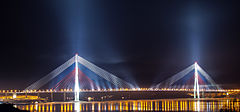Our website is made possible by displaying online advertisements to our visitors.
Please consider supporting us by disabling your ad blocker.
Cable-stayed bridge
This article includes a list of general references, but it lacks sufficient corresponding inline citations. (July 2020) |
 The Russky Bridge in Vladivostok has a central span of 1,104 metres (3,622 ft), the world's longest cable-stayed bridge span as of 2024. | |
| Ancestor | Suspension bridge |
|---|---|
| Related | Extradosed bridge |
| Descendant | Side-spar cable-stayed bridge, Self-anchored suspension bridge, cantilever spar cable-stayed bridge |
| Carries | Pedestrians, bicycles, automobiles, trucks, light rail |
| Span range | Medium to Long |
| Material | Steel rope, post-tensioned concrete box girders, steel or concrete pylons |
| Movable | No[citation needed] |
| Design effort | medium |
| Falsework required | Normally none |

A cable-stayed bridge has one or more towers (or pylons), from which cables support the bridge deck. A distinctive feature are the cables or stays, which run directly from the tower to the deck, normally forming a fan-like pattern or a series of parallel lines. This is in contrast to the modern suspension bridge, where the cables supporting the deck are suspended vertically from the main cable, anchored at both ends of the bridge and running between the towers. The cable-stayed bridge is optimal for spans longer than cantilever bridges and shorter than suspension bridges. This is the range within which cantilever bridges would rapidly grow heavier, and suspension bridge cabling would be more costly.
Cable-stayed bridges were being designed and constructed by the late 16th century,[1] and the form found wide use in the late 19th century. Early examples, including the Brooklyn Bridge, often combined features from both the cable-stayed and suspension designs. Cable-stayed designs fell from favor in the early 20th century as larger gaps were bridged using pure suspension designs, and shorter ones using various systems built of reinforced concrete. It returned to prominence in the later 20th century when the combination of new materials, larger construction machinery, and the need to replace older bridges all lowered the relative price of these designs.[2]
- ^ "Types of Bridges". History of Bridges. Retrieved 12 October 2020.
- ^ Nordrum, Amy. "Popular Cable-Stay Bridges Rise Across U.S. to Replace Crumbling Spans". Scientific American. Retrieved 30 April 2017.
Previous Page Next Page


